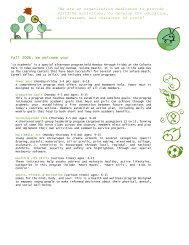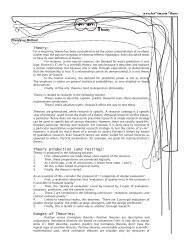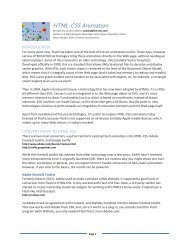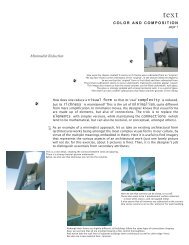ULTRAPERFORMING Beams/ Columns Doors ... - fen-om data
ULTRAPERFORMING Beams/ Columns Doors ... - fen-om data
ULTRAPERFORMING Beams/ Columns Doors ... - fen-om data
Create successful ePaper yourself
Turn your PDF publications into a flip-book with our unique Google optimized e-Paper software.
Biopaver<br />
Every parking lot, driveway, sidewalk and road is an impervious surface acting as an unbroken<br />
barrier between the wet rain falling fr<strong>om</strong> the sky and the dry earth below. Water draining fr<strong>om</strong><br />
these surfaces gains speed and quickly rolls off all exposed ground, and even minor rains<br />
bec<strong>om</strong>e small scale floods eroding what little soil is exposed, quickly filling municipal storm<br />
systems. Biopaving is a “green” solution for storm water management that integrates impervious<br />
surfaces and islands of bi<strong>om</strong>itigating and bioremediating plant material. These bio-islands of<br />
phytoremediating plants are manufactured into the product and unwrapped by the environment<br />
after installation through biodegradation. The Biopaver is an innovative interlocking concrete<br />
paver with prepackaged soil and phytoremediating planting material. Once the paver is exposed<br />
to the elements, the mold and packaging biodegrade and help set the paver into place, and<br />
bioremediating plants begin to grow. These tough plants filter the contaminants fr<strong>om</strong> the storm<br />
water as it passes through this pervious heart of the paver.<br />
www.biopaver.c<strong>om</strong><br />
B<strong>om</strong>bproof Fiber-Metal<br />
After a b<strong>om</strong>b went off in 1988 on Pan Am flight 103 over Lockerbie, Scotland, killing all 259<br />
passengers onboard, the Federal Aviation Administration created standards that industry<br />
would have to meet if it chooses to deploy luggage containers capable of withstanding such a<br />
blast. During the 1990s, the FAA tested 10 hardened luggage containers made fr<strong>om</strong> a variety<br />
of materials, including reinforced aluminum, fiberglass, aramid fibers and polymers. Only one<br />
container - concocted fr<strong>om</strong> fiber-metal laminates developed originally by the Delft University of<br />
Technology in the Netherlands - passed the FAA’s test and received certification. The material,<br />
called Glare (short for glass reinforced), consists of multiple aluminum layers interspersed with<br />
layers of fiberglass and adhesive bonding that are supple yet strong. When used in fabricating<br />
luggage containers, Glare can absorb b<strong>om</strong>b blasts without breaching. As Glare expands with a<br />
blast, it absorbs the explosive energy and redistributes the impact load to the adjacent surface<br />
area rather than to one specific weak spot. The b<strong>om</strong>b blast leaves a sizable deformation in the<br />
container’s surface, but it remains intact. Moreover, whereas other FAA-tested containers were<br />
also able to contain the b<strong>om</strong>b blast, Glare could resist the subsequent luggage-fueled fire inside<br />
the container.<br />
www.galaxyavsec.c<strong>om</strong><br />
Corrugated Aluminum Panels<br />
Doluflex panels consist of a corrugated aluminum plate machined with a cold forming system<br />
and laminated between various materials. Doluflex 1 is a flexible panel used to produce bent<br />
elements, and Doluflex 2 is an extremely stiff sandwich panel. Shaped structural panels are<br />
also manufactured using Doluflex 2. Traditionally used in the ship-building industry, Doluflex<br />
panels possess high chemical-physical resistance which make them suitable for building facade<br />
systems. Doluflex can be worked with normal carpentry tools, and is classified non-c<strong>om</strong>bustible<br />
according to RINA, Lloyd’s Register and Det Norske Veritas. The Doluflex 2 panel has a total<br />
thickness of 5 mm, a transversal resistance to bending stress E x l = 2.48 x 106 and longitudinal<br />
resistance to bending stress E x l = 1.97 x 106, with a total weight of 8.1 Kg/m².<br />
www.donatigroup.it/inglese/default2.asp?lingua=eng<br />
Fly-Ash Concrete<br />
Contents: 50% fly ash, 50% cement Use: Building-walls, foundations Bonuses: Fly ash, produced<br />
in abundance by coal-burning power plants, replaces a high volume of cement, which is third on<br />
the top ten list for CO2 emissions. Problems: Rutherford-Chekene’s structural engineer Afshar<br />
Jalalian, who created this mix for U.C. Berkeley’s Wurster Hall seismic retrofit project, says: “The<br />
concrete dries at a slower rate; this is really not a problem but builders will need to adapt.” Also,<br />
fly ash (a mixture of alumina, silica, unburned carbon, and metallic oxides) is extremely toxic,<br />
though it may be that the concrete immobilizes its impurities.<br />
Frit<br />
Frit is the trade term used to describe recycled glass once it has been ground down into a<br />
fine sand. Generally ‘Frit’ is seen as a midway stage in a longer manufacturing process and is<br />
normally supplied as a raw material for making tiles or even recycled glass bottles. However, Frit<br />
has an aesthetic all of its own and can be used in a variety of ways which don’t involve melting<br />
or pressing. TriVitro in Seattle makes specially sized and colored chips of recycled glass for use<br />
in terrazzo flooring, tiles, counter tops, concrete pavers, wall finishes and exposed aggregate








